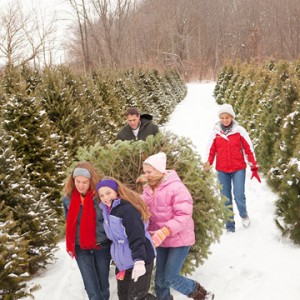Our florists here at Belle Fiori hope that all of our Milwaukee area clients enjoyed a safe and festive Thanksgiving holiday! As we prepare for the upcoming season filled with plenty of Christmas and holiday floral arranging, we can’t help but get excited at the prospect of homes filled with flowers and evergreens fit for special occasions.
With evergreens in mind, check out the Better Homes and Gardens guide to choosing the best type of Christmas tree for your home!
A Christmas Tradition
For many, the yearly adventure of trudging off, bundled with hats and scarves to pick the perfect Christmas tree has long been a family tradition not to be missed. While most people have a routine to selecting their tree, we asked Rick Dungey from the National Christmas Tree Association to give insight on what is new for the season and what tips he has for making your tree last the whole season.
The Real Deal
There are several advantages to selecting a real Christmas tree, beyond their fragrant appeal. First and foremost, evergreens are 100 percent biodegradable and once the season is over, can be recycled for a variety of purposes benefiting wildlife and nature in general.
Secondly, they contain no chemical residue while fake, plastic trees are made of PVC, a dangerous chemical.
And lastly, purchasing a fresh-cut Christmas tree supports a local tree farmer (most artificial trees are made overseas and shipped to North America).
Types of Trees
Although region plays a large part in what types of evergreens are available, Dungey finds the most popular varieties are balsam fir, Douglas fir, noble fir, Scotch pine, Virginia pine, and eastern white pine mainly because of how easy they are to grow. However, across the United States, there are more than 35 different species of evergreens grown for their Christmas appeal.
Here is our roundup of some of the most common evergreens available:
Douglas Fir: Boasting a pyramidal shape and blue to dark green needles, Douglas fir (Pseudotsuga menziesii) is a dependable, long-lived cut tree. It flourishes in mild, humid climates with dry summers.
Fraser Fir: A regal, richly fragrant native tree,Abies fraseri has bicolor needles — deep green on top, silvery white below. Its generally slender profile suits small rooms. Grow it only in cold-winter, cool-summer climates.
Noble Fir: With its cool blue-green, well-spaced branches and densely set, upwardly curved needles, Abies procera is aptly named. It’s most often a cut tree, since it grows happily only in its Pacific Northwest home.
Scotch Pine: A classic conical shape and excellent needle retention make Pinus sylvestristhe most popular cut tree of the holidays. It’s also easy to grow because it’s adapted to a wide range of climates and soils.
Eastern White Pine: Soft green color, long needles, and rich fragrance make Pinus strobusworthy of yuletide focus. Adaptable, fast growing, and moisture loving, this pine produces long, decorative cones.
Virginia Pine: One of the few evergreens to tolerate warm winter temps, Pinus virginiana is a first pick among Christmas trees for Southerners. It’s also a good cut tree because, like all pines, it holds its needles well.
Grand Fir: With bicolor needles — deep green on top, white-striped underneath — Abies grandismakes a rich foil for ornaments. It grows well where winters are long, summers are cool, and the air is humid and pristine.
Eastern Red Cedar: Native to the eastern half of North America, Juniperus virginiana makes a great cut or living tree with homespun appeal and pungent fragrance. In the landscape, it tolerates drought, wind, and cold.
No matter which variety you choose, we hope you enjoy the mood set by your freshly cut pine-there’s really nothing better!

